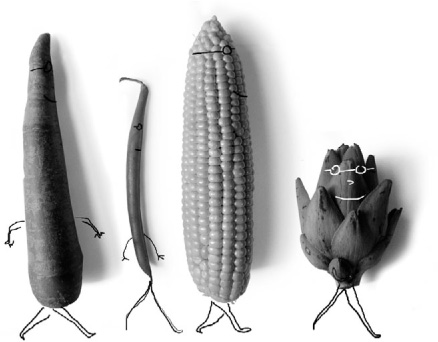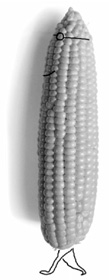

The great thing about vegetables is that the less you do to them, the more nutritious and flavorful they are. Unfortunately, many people have gotten into the habit of using canned veggies or smothering fresh ones with cheese or sauce to entice their kids to eat them. But the best way to retain the distinct flavor and texture of vegetables is to steam or stir-fry them.
Fresh vegetables are always preferable, but frozen peas, spinach, corn kernels, and cauliflower taste okay if cooked for slightly less time than instructed on the package. Avoid canned vegetables with these few exceptions: artichokes, corn packed in water, and stewed tomatoes.
Getting your kids to eat vegetables (let alone the 3–5 servings a day recommended by the USDA) can be a battle. Be resourceful: put carrot sticks or cucumber slices on your child’s lunch plate instead of potato chips. Add a cup of frozen peas or cut green beans to your tomato sauce. It also helps to give your children a choice: “Okay, kids, what do you want tonight? Broccoli or cauliflower?” Then hold them to their decision.
When cooking vegetables, less is more. To preserve color, flavor, and nutrition, we recommend the following methods. Cooking times are for crunchy (al dente) vegetables. For vegetables without any crunch, cook a bit longer but not so long that they become mushy and dull.
Bring 1–2 inches of water to a boil in a saucepan on high heat. Add the vegetables. (Do not fill more than halfway with vegetables.) When the water returns to a boil, reduce the heat to low, cover the pan tightly, and simmer for the prescribed amount of time. To blanch vegetables, boil a full pot of water, plunge the vegetables in, and remove after 30 seconds to 1 minute. Rinse vegetables under cold water.
Fill a medium-sized pot with 1–2 inches of cold water. Set the vegetable steamer in the pot. (The water level should not reach the bottom of the steamer.) Place the vegetables in the steamer and cover the pot tightly.
Bring the water to a boil on high heat. When the water boils, reduce the heat to low and steam for the prescribed amount of time.
Unless a recipe states otherwise, put the vegetables in a microwave-safe bowl just large enough to hold them comfortably. Add 2 tablespoons water and cover tightly with microwavable plastic wrap. Cook on high heat for the prescribed amount of time. (Times given in this chapter are for large, high-wattage microwave ovens. Small, low-wattage oven owners should add 30% more time.) Remove the vegetables from the microwave, let them sit, covered, for a few finished cooking, then lift the plastic carefully.

Heat 2 tablespoons vegetable oil in a heavy frying pan or wok on high heat and let it get very hot, about 1 minute. Add the cut-up vegetables all at once and fry, stirring continuously, until they are cooked but still slightly crunchy, usually about 4 minutes. Add 1 minced clove of garlic and/or 2 tablespoons soy sauce, and stir-fry for 1 minute more before serving. There are a number of interesting Asian sauces available in supermarkets that you can add instead of plain soy sauce.

Artichokes are surprisingly easy to prepare and the involved process of eating them makes them especially appealing.
Freshness
Fresh artichokes are distinguished by their bright-green color, tightly packed leaves, and absence of brown spots.
Preparation
Pull off tough outside leaves. Cut off the entire stem and trim about ½ inch from the top. Trim the tip of each leaf with scissors. Rinse well.
Portion Size
1 artichoke per person.
Cooking
To steam: Place the artichokes, stem side down, in a pot just large enough to accommodate them. Add 2 inches water, 2 teaspoons salt, and 2 lemon slices. Bring the water to a boil on high heat. When the water boils, immediately turn the heat to low, cover, and steam for 35–45 minutes, depending on the size of the artichokes. They are done when a middle leaf can be pulled out with ease. Remove the artichokes from the pot with tongs and turn them over in a colander to drain.
To microwave: Loosely wrap each artichoke individually in plastic wrap. Cook 1 artichoke for 7 minutes; 2 artichokes for 10 minutes; 4 artichokes for 12–15 minutes.

Eating
Place the artichoke in the center of a plate. To eat, gently tug on a leaf to remove it, then scrape off the meaty bottom portion of the leaf with your teeth. The rest of the leaf is inedible. After all the leaves have been eaten, you’ll have worked your way down to the choke, which is covered with fuzz and very small leaves. Cut off the fuzz and discard. Underneath is the meaty bottom, called the heart, which is a delicacy. The leaves and heart can be sprinkled with lemon juice or dipped in different sauces, such as melted butter, a vinaigrette, or hollandaise sauce.
Asparagus is a curious vegetable in that it has no real leaves, only small nibs that run along the stalk. No longer the expensive delicacy it once was, asparagus is now generally available year-round.
Freshness
Look for firm, green stalks. The cluster at the top should be tightly closed and firm.
Preparation
Stalks can be thin, medium, or wide. All need about 1 inch trimmed off the end. If you bend the stalk, it will break at the right point. Thicker stalks, those that are 10–12 to a pound, need to be trimmed and peeled. Use a vegetable peeler to gently scrape off the tough outer skin, working from the middle of the stalk down to the end.
Portion Size
6 stalks per person.
Cooking
To steam: Place asparagus in an asparagus steamer with the water boiling—4 minutes for thin stalks, 6 minutes for medium stalks, and 8 minutes for thick stalks. Asparagus should be cooked through but still slightly crunchy.
To boil: Use a wide pot or deep frying pan to accommodate the asparagus. Fill halfway with water, add 2 teaspoons salt, and bring the water to a boil. Add the asparagus all at once. Cook 4 minutes for thin stalks, 6–7 minutes for medium stalks, and 8–9 minutes for thick stalks.
To microwave: Because of their delicacy and quick cooking time, it is not advisable to cook asparagus in the microwave.
Serving
Asparagus is traditionally served with hollandaise or béarnaise sauce. Just as satisfying is a bit of butter, salt, and pepper. It can also be served chilled with a tangy vinaigrette (see box).
Like great actors in bad plays, beets have been cast poorly, canned in water or in jars of sweet syrup. But fresh medium-sized beets, simply cooked, can be a surprisingly wonderful addition to a meal.
Freshness
Beets should be hard with no wrinkles, bruises, or soft spots. Choose beets that are slightly larger than a golf ball.
Preparation
Trim the stems, leaving about an inch. Rinse gently. (Do not scrub or you could puncture the skin, which will cause the juice to run during cooking and cause a considerable loss of flavor.)
2 medium-sized beets per person.
Cooking
To boil: Put the beets in a pot and add water to cover them halfway. Cover the pot and bring the water to a boil. Reduce the heat to low and simmer for 35–45 minutes. When soft, transfer the beets to a large bowl of cold water. Slip off the skins with your fingers as soon as the beets are cool enough to handle.
To bake: Trim the stems and place the unwashed beets in an aluminum foil-lined casserole. Bake in a 325°F oven for about 1½ hours. Peel the skin with a paring knife when the beets are cool enough to handle.
To microwave: Trim the stems and wrap each beet loosely in plastic wrap. On high setting, cook ½ pound of medium beets for 12–13 minutes. Cook 1 pound for 16–17 minutes. Peel the skin with your fingers or a paring knife when the beets are cool enough to handle.
Serving
Slice the beets and serve dotted with butter and a sprinkling of dill, salt, and pepper; or sprinkle with white vinegar.
Broccoli is always available and is highly nutritious, boasting large amounts of vitamins A and C. It also scores high in iron, calcium, and potassium content. Like other members of the cabbage family, it has been shown to be helpful in the prevention of some kinds of cancer.
Freshness
Look for bunches that have abundant florets with tightly packed buds. Also look for the thinnest stalks. Avoid any bunches with yellowing areas or buds that have begun to flower.
Preparation
Rinse the broccoli. Trim 1 inch or more off the stem, depending on how thick and tough it is. Snap off the florets and then slice the stalks into ½-inch medallions.
Portion Size
1 bunch (3 stalks) serves 4–5.
To steam: Steam for 8–10 minutes. Stems will be slightly crunchy.
To boil: Boil for 6–8 minutes.
To microwave: Microwave 3 cups florets for 4–5 minutes, stirring once.
Serving
Broccoli is great plain, seasoned with salt and pepper or topped with a sprinkling of freshly grated Parmesan cheese. Or serve with a simple sauce, heated until warm, of equal proportions fresh lemon juice and butter with a dollop of Dijon mustard.
Carrots are inexpensive and are always available. Lightly seasoned and not overcooked, they make a tasty and highly nutritious side dish.
Freshness
Carrots are usually packed in plastic bags that are deceptively tinted orange, making it difficult to tell the color of the carrots inside. Try to find firm, bright orange carrots that have no sprouts at their tops. Carrots sold with green tops taste fresher and do not need to be peeled.
Preparation
Cut carrots into ½-inch circles or slice lengthwise in quarters and cut into 3-inch sticks.

Portion Size
1 medium-sized carrot per person.
Cooking
To steam: For firm carrots, steam for 8–10 minutes.
To boil: Boil for 6–8 minutes.
To microwave: For 5 carrots, microwave for 5 minutes, stirring once.
Serving
Serve carrots seasoned with a pinch of salt and pepper, and if you like, a bit of chopped fresh dill or mint.
Perhaps because of its nonthreatening color and somewhat mild flavor, cauliflower is often popular with kids.
Freshness
Look for heads that are firm and white with no brown spots. The florets should be tightly packed. If the head develops a few brown spots in the fridge, simply trim them away. The rest is perfectly fine.
Preparation
Cut the head in half lengthwise. Using a paring knife, cut the florets from the main stalk. Cut any extra-large florets in half lengthwise.
Portion Size
1 medium-sized head serves 6.
Cooking
To steam: Steam for 8–10 minutes.
To boil: Boil for 6–8 minutes.
To microwave: For 1 medium size head, cut into florets, microwave for 4 minutes.
Serving
Serve with salt and pepper and an optional dot of butter or a sprinkling of freshly grated Parmesan, if desired.
The taste of the first locally grown ears of corn is bittersweet, for as delicious as they are, they mean that summer is nearing its end.
Freshness
Try to find a market or stand that sells fresh local corn. Peel back the husk a bit and check inside to see if the kernels are small, packed tightly, full and shiny, and that there are no shriveled areas or worm holes. Florida farmers now grow excellent hybrids, giving us sweet-tasting corn starting in late spring.

Preparation
Keep corn refrigerated and shuck as close to cooking time as possible.
Portion Size
1½ ears per person.
Cooking
To boil: Place corn in a large pan with enough water to just cover the ears. Boil for 3–5 minutes.
To microwave: Wrap 4 ears of corn in microwavable plastic, microwave for 8 minutes (2 minutes each), turning once.
Serving
Serve with butter and salt and pepper. Extremely fresh corn, however, needs no enhancement. Give the kids corn holders or just run an ear under cold water for a few seconds until it is cool enough for them to hold.
Fresh green beans are a far cry from the tasteless, waxy canned beans served in school cafeterias. They can be prepared in a variety of ways, none of which will remind you of the soggy green horrors of your youth.
Freshness
Look for firm beans of a rich green color without any shriveling at the ends. If you can get away with it, snap one and eat it. It should be crisp and slightly sweet.
Preparation
Rinse the beans and cut ¼ inch from each end. Cut in half or thirds if desired. This is about a 5–10 minute job that the kids can help you with.
Portion Size
¾ pound serves 4.
Cooking
To steam: For crunchy beans, steam for 6–8 minutes.
To boil: Boil for 5–7 minutes.
To microwave: For 1 pound of beans, microwave for 6–8 minutes.
Stir-fry: Green beans lend themselves very well to stir-frying. Just before they are finished cooking, add 1 clove minced garlic and 2 tablespoons soy sauce to the pan.
Serving
Serve plain beans with a dot of butter, and salt and pepper.
America is finally waking up to the world of mushrooms. Wild mushrooms, such as shiitake, porcini, oyster, and even morel, are becoming popular in home kitchens. And with good reason, for their earthy taste can earn them a starring role in many intriguing recipes. Or they can be served as a side dish. Even the common button mushroom can enhance a recipe significantly.
Freshness
Mushrooms shouldn’t have any slimy spots or other signs of decay. The membrane under the cap should be attached to the stem. Button mushrooms that are just slightly brown are fine for sauces, but only the freshest should be eaten raw in salads. All wild mushrooms should be cooked through before eating.
Preparation
Trim the stems of the mushrooms. Unless the tops have bits of dirt on them, they should not be cleaned. If there is dirt, brush it off or wipe the caps with a slightly damp cloth or paper towel. Never immerse the mushrooms in water. For most recipes, mushrooms are cut lengthwise into thin slices.
Portion Size
¼ pound per person.

Cooking
Do not boil or steam mushrooms.
To sauté: Heat 3 tablespoons butter, margarine, or oil in a large (non-iron) frying pan over medium-high heat until hot, about 45 seconds. Add 1 pound sliced mushrooms and cook, stirring occasionally, until they are soft and lose their moisture, about 8 minutes. Mushrooms shrink considerably during cooking.
Besides being a real delicacy, fresh peas can also keep the kids busy. Have them shell the peas while you prepare the rest of the meal.
Freshness
The pods should be a deep green color. Before purchasing, snap one open and make sure the peas inside are glossy and full, and taste fresh and sweet.
Shell the peas. Do not rinse before cooking.
Portion Size
About ¾ pound per person (weighed before shelling).
Cooking
To boil: For peas with a bite to them, boil for 6 minutes. Boil 8 minutes for softer peas.
To microwave: For ½ pound of shelled peas, microwave for 3 minutes, stirring once.
Serving
Serve peas with a pinch of salt and pepper, or an optional dot of butter.
Popeye notwithstanding, kids don’t often take to spinach. Nevertheless, it’s extremely nutritious, a cinch to prepare, and tastes good to most adults.
Freshness
Spinach is most often sold prewashed in 1-pound plastic bags or not very well washed in tied bundles. Avoid bags or bundles with leaves that are dark and moist or yellowed.
Preparation
Pinch off the stems and put the leaves in a large bowl filled with cold water. Swish the leaves around and lift them from the water into a colander set in the sink. Pour out the water from the bowl, rinse out any grit that has collected on the bottom, and fill the bowl again with cold water. Return the spinach to the bowl and swish it around again. Then lift out the leaves and shake off the excess water. It is now ready for cooking. Packaged “prewashed” spinach needs to be rinsed only once.
A generous ¼ pound uncooked spinach per person.
Cooking
To boil: Put the spinach in a large, heavy-bottomed pot with a tight-fitting lid. Do not add water. The water remaining on the leaves from washing will be enough to cook the spinach. Cover the pot and turn the heat to medium low. Cook for about 6 minutes, until all the leaves are wilted. Turn the spinach a couple of times with tongs while it is cooking to keep the bottom leaves from burning.
To microwave: For 1 pound of spinach, microwave for 6–8 minutes, stirring twice.
Serving
Transfer the spinach to a colander to drain. Serve immediately with a light seasoning of salt and pepper.
The thinnest zucchini are best. Kids may not eat them plain, but mixed with tomato sauce and sprinkled with Parmesan, they become a popular side dish.
Freshness
Zucchini should be very firm with no scrapes or bruises.
Preparation
Zucchini need to be rinsed well. Rub them with your hand to get rid of stubborn fuzz and grit. Trim both ends and cut into ½-inch rounds. Or slice lengthwise into quarters and cut into 3-inch sticks.
Portion Size
1 small zucchini per person.
Cooking
Do not boil zucchini.
To steam: Steam for 6–8 minutes.
To microwave: For 3 small zucchini, in ¼-inch slices, microwave for 2½ minutes, stirring once.
To sauté: Heat 2 tablespoons olive oil in a heavy frying pan on high heat until it gets hot, about 30 seconds. Add the zucchini and sauté, stirring and turning often, until soft but still crunchy, about 5 minutes. Add 1 minced garlic clove and sauté for 1 minute more.
Serving
Sprinkle zucchini with a pinch of salt and pepper and some grated Parmesan cheese, if desired.